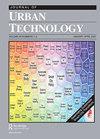Smart World Cities in the 21st Century
IF 4.6
3区 经济学
Q1 URBAN STUDIES
引用次数: 0
Abstract
The “smart city” concept has been increasingly popular both in scientific literature and urban policy. In recent decades, the emergence of new technologies, such as the Internet of Things (IoT), cloud computing, and artificial intelligence (AI), has facilitated a new wave of smart city development practices across the world (Caragliu et al., 2011; Albino et al., 2015). Nevertheless, it is still not clear what characterizes the smart city other than technologies. In this regard, Agnes Mainka’s Smart World Cities in the 21st Century is an ambitious attempt to explore the impacts of political willingness, infrastructure, and the world city status on the state and development of smart cities. This work intends to develop the underlying theories on cities in the twenty-first century by a global comparison of cities in Europe (e.g., London, Paris, Amsterdam), North America (e.g., New York, San Francisco, Toronto), Asia (e.g., Beijing, Tokyo, Singapore), South America (e.g., São Paulo), and Australia (e.g., Sydney, Melbourne). The book is divided into seven chapters. Chapter 1 provides a very brief introduction of informational world cities. The author cites her previous work and explains why she adopted the term “informational world cities” which combines different types cities and the associated infrastructures. The chapter also provides the basic structure of the book. In Chapter 2, the author provides an overview of urban development in the context of the knowledge society. Following Stock (2011:13), she defines the factors of the information and knowledge society and further proposes the defining factors associated with the smart society:21世纪的智慧世界城市
“智慧城市”的概念在科学文献和城市政策中越来越受欢迎。近几十年来,物联网(IoT)、云计算和人工智能(AI)等新技术的出现,推动了全球范围内智慧城市发展实践的新浪潮(Caragliu et al., 2011;Albino et al., 2015)。然而,除了技术之外,智慧城市的特征还不清楚。在这方面,Agnes Mainka的《21世纪的智慧世界城市》是一项雄心勃勃的尝试,旨在探讨政治意愿、基础设施和世界城市地位对智慧城市状态和发展的影响。这项工作旨在通过对欧洲(如伦敦、巴黎、阿姆斯特丹)、北美(如纽约、旧金山、多伦多)、亚洲(如北京、东京、新加坡)、南美(如圣保罗)和澳大利亚(如悉尼、墨尔本)城市的全球比较,发展关于21世纪城市的基本理论。这本书分为七章。第一章简要介绍了信息化的世界城市。作者引用了她以前的工作,并解释了为什么她采用了“信息世界城市”一词,将不同类型的城市和相关的基础设施结合在一起。本章还提供了本书的基本结构。在第二章中,作者概述了知识社会背景下的城市发展。继Stock(2011:13)之后,她定义了信息和知识社会的因素,并进一步提出了与智慧社会相关的定义因素:
本文章由计算机程序翻译,如有差异,请以英文原文为准。
求助全文
约1分钟内获得全文
求助全文
来源期刊

Journal of Urban Technology
URBAN STUDIES-
CiteScore
8.50
自引率
4.20%
发文量
42
期刊介绍:
The Journal of Urban Technology publishes articles that review and analyze developments in urban technologies as well as articles that study the history and the political, economic, environmental, social, esthetic, and ethical effects of those technologies. The goal of the journal is, through education and discussion, to maximize the positive and minimize the adverse effects of technology on cities. The journal"s mission is to open a conversation between specialists and non-specialists (or among practitioners of different specialities) and is designed for both scholars and a general audience whose businesses, occupations, professions, or studies require that they become aware of the effects of new technologies on urban environments.
 求助内容:
求助内容: 应助结果提醒方式:
应助结果提醒方式:


